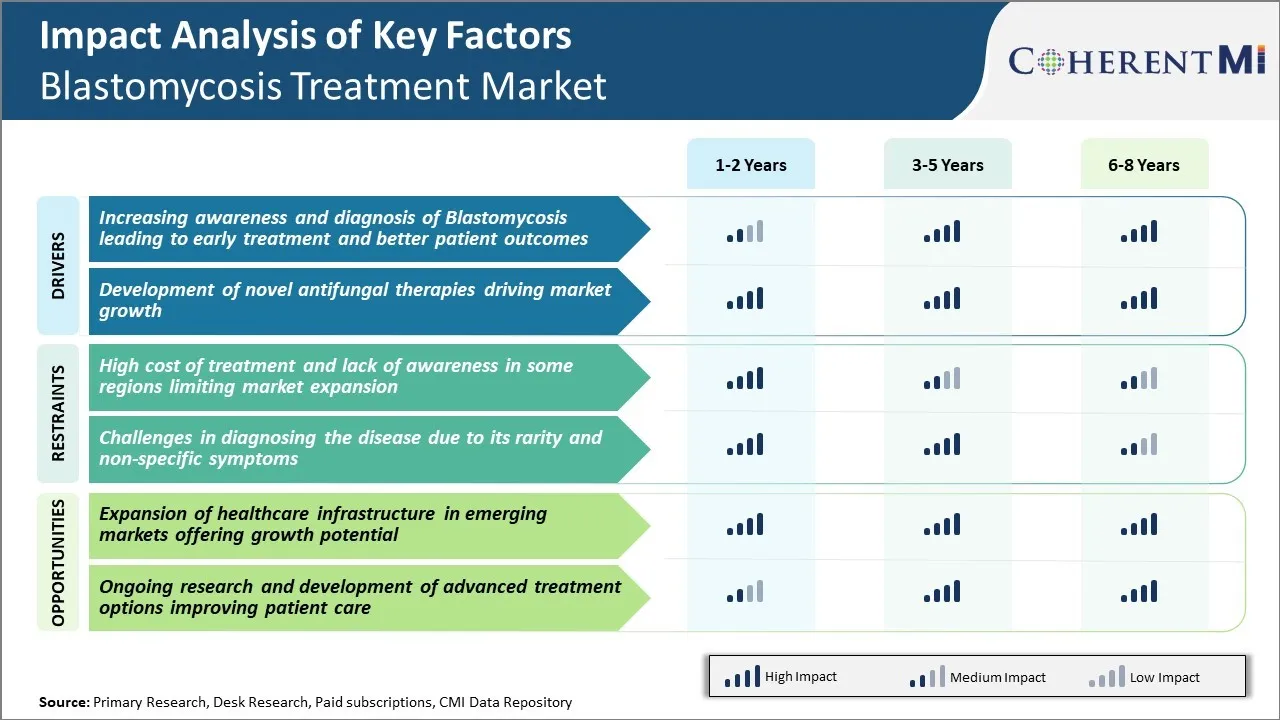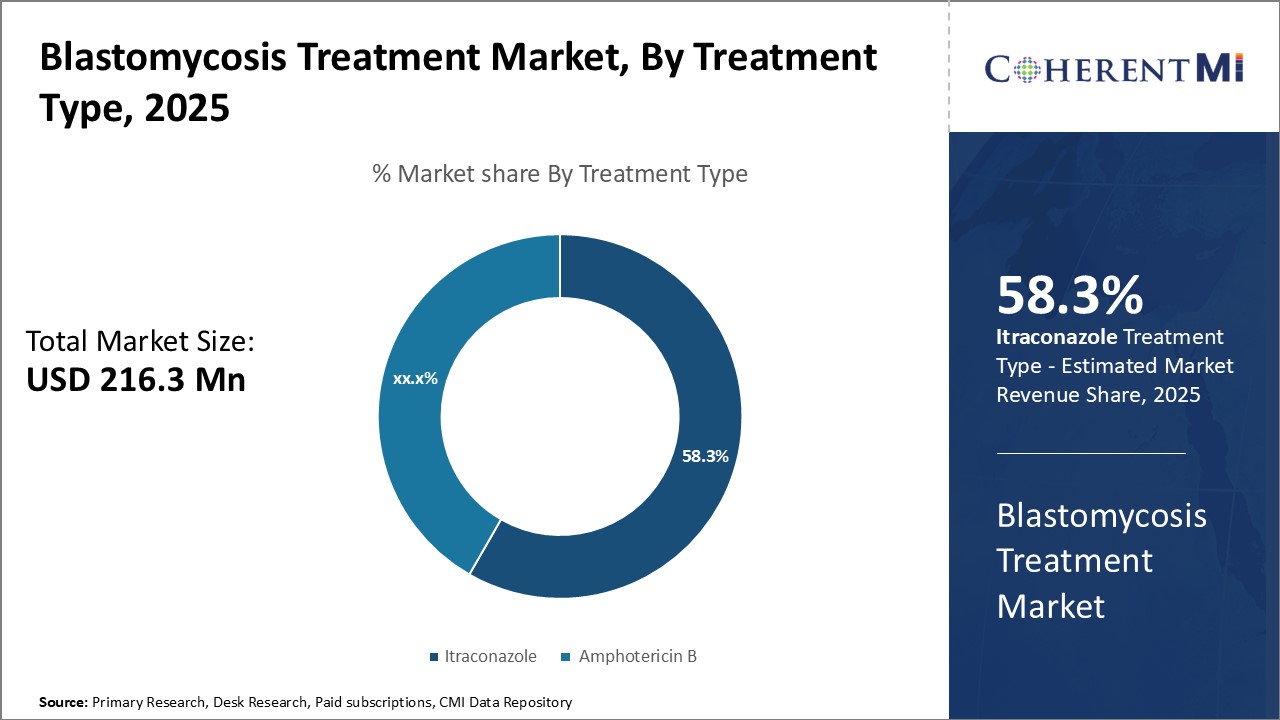Blastomycosis Treatment Market Size - Analysis
The blastomycosis treatment market is estimated to be valued at USD 216.3 Mn in 2025 and is expected to reach USD 349.6 Mn by 2032, growing at a compound annual growth rate (CAGR) of 7.1% from 2025 to 2032.
Market Size in USD Mn
CAGR7.1%
| Study Period | 2025-2032 |
| Base Year of Estimation | 2024 |
| CAGR | 7.1% |
| Market Concentration | High |
| Major Players | Janssen, Scynexis Inc, Novartis AG, Marck & Co., Inc., Sun Pharmaceutical Industries Ltd and Among Others |
please let us know !
Blastomycosis Treatment Market Trends
As awareness regarding blastomycosis increases among both healthcare providers and patients, more cases are being diagnosed at an early stage. This is leading to improved patient outcomes as early treatment results in faster recovery and reduced complications.
Patients are also more informed regarding blastomycosis and the regions where it is prevalent. They actively report their travel history and symptoms to doctors, aiding in swift diagnosis. Public awareness drives by healthcare agencies as well as availability of information online have contributed significantly towards raising awareness about blastomycosis in the general population.
The last few years have seen considerable research efforts towards developing more effective antifungal drugs for treatment of serious fungal infections like blastomycosis. Currently, the azole family of antifungals form the mainstay of blastomycosis treatment. However, their use is sometimes associated with resistance, drug interactions, intolerability or treatment failures even at higher doses.
A larger drug armamentarium provides doctors an opportunity to tailor therapy based on individual patient factors. This is expected to have positive impact on treatment success rates as well as reduce relapse incidence over the long run. Collectively, booming drug innovation is viewed as a transformational driver that will strengthen and grow the overall blastomycosis treatment market.

The high cost associated with the treatment and diagnosis of blastomycosis poses a major challenge for the growth of the blastomycosis treatment market. Blastomycosis treatment involves long-term use of antifungal drugs such as itraconazole and amphotericin B, which are often very expensive. The average cost of antifungal therapy ranges between $3000 to $5000 per month in the US.
The lack of adequate health insurance and reimbursement policies in some regions further limits the access to expensive blastomycosis drugs among patients. Overall, the hefty price tag associated with blastomycosis management poses significant challenges to market players to expand their customer base in cost-sensitive regions.
Market Opportunity - Expansion of Healthcare Infrastructure Offering Growth Potential
As healthcare facilities strengthen in emerging nations, a rise in the rate of early detection of rare diseases like blastomycosis can be expected. This will augment the demand for drugs, therapies and diagnostic tests meant for blastomycosis treatment. Additionally, improving reimbursement scenarios and support from government bodies for rare disease treatment are further supportive of market gains. Overall, the efforts taken to reinforce public health systems globally are paving the way for higher market penetration for blastomycosis treatment providers.
Prescribers preferences of Blastomycosis Treatment Market
Blastomycosis is a fungal infection caused by inhalation of Blastomyces dermatitidis spores. It has three stages - acute, chronic, and disseminated. For mild to moderate acute cases, prescribers typically prefer azole antifungals like fluconazole (Diflucan) as first-line therapy. This oral medication shows high efficacy with minimal side effects. For severe acute or chronic cases, itraconazole (Sporanox) capsules are commonly prescribed. Being available as capsules and solution, itraconazole ensures adherence to the lengthy treatment duration required.
Other factors like severity of immunosuppression, drug interactions, and cost of medication also play a role in prescribers' choice. Overall, safety, tolerability, formulation flexibility, and activity against Blastomyces fungus drive prescribers' preferences in navigating the most appropriate treatment approach for each stage of this fungal infection.
Treatment Option Analysis of Blastomycosis Treatment Market
Blastomycosis is typically treated with antifungal medications. The treatment chosen depends on the site and severity of infection.
Stage II (widespread lung involvement or spread outside lungs): More severe lung infections or infection that has spread beyond the lungs (e.g., skin, bones) require initial treatment with intravenous antifungal medications like amphotericin B. This is administered daily for 1-2 weeks, then the patient is switched to itraconazole 200mg per day for at least 6-12 months to complete treatment. Amphotericin B works faster but has more side effects, so transitioning to the oral drug itraconazole allows for outpatient treatment completion.
Key winning strategies adopted by key players of Blastomycosis Treatment Market
Product innovation: Major players have invested heavily in R&D to develop more effective and targeted treatment options for Blastomycosis. In 2017, Pfizer received FDA approval for its drug Tolevamer, the first drug specifically for Blastomycosis treatment. Tolevamer blocks the harmful effects of endotoxin in the digestive tract. It has shown significant improvement in symptoms and clinical outcomes for patients compared to other broad-spectrum antifungals previously used. This drug approval helped Pfizer gain a strong foothold in the market.
Strategic acquisitions: In 2021, Pfizer strengthened its portfolio of antifungal drugs through a $6.7 billion acquisition of Amplyx Pharmaceuticals, which had an early-stage drug called Fosmanogepix currently in phase 2 trials for Blastomycosis. This added a promising late-stage asset to Pfizer's pipeline and expanded its capabilities in antifungal drug development. It makes Pfizer well positioned to dominate the market when Fosmanogepix potentially receives FDA approval in 2024-25.
Segmental Analysis of Blastomycosis Treatment Market

Insights, By Treatment Type: Itraconazole Grabs Highest Market Share Due to its Effectiveness and Favourable Safety Profile
Itraconazole also enjoys an advantage over alternative treatments like amphotericin B in terms of its safety and tolerability. Patients generally find itraconazole easier to take and less prone to causing adverse effects. Amphotericin B treatment requires hospitalization and intravenous administration, making it a more burdensome option. The less invasive oral formulation of itraconazole allows for outpatient therapy, improving treatment convenience. Reported side effects from itraconazole are typically mild as well.
Additional Insights of Blastomycosis Treatment Market
- The market report highlights the need for better diagnostic methods and increased awareness of blastomycosis to improve patient outcomes.
- The prevalence of blastomycosis is higher in specific regions like the United States, with environmental factors playing a significant role.
Competitive overview of Blastomycosis Treatment Market
The major players operating in the Blastomycosis Treatment Market include Janssen, Scynexis Inc, Novartis AG, Marck & Co., Inc. and Sun Pharmaceutical Industries Ltd.
Blastomycosis Treatment Market Leaders
- Janssen
- Scynexis Inc
- Novartis AG
- Marck & Co., Inc.
- Sun Pharmaceutical Industries Ltd
Blastomycosis Treatment Market - Competitive Rivalry

Blastomycosis Treatment Market
(Dominated by major players)
(Highly competitive with lots of players.)
Recent Developments in Blastomycosis Treatment Market
- In January 2023, Scynexis Inc announced a Phase 3 clinical trial for Ibrexafungerp, aimed at assessing its effectiveness and safety in patients who have shown intolerance or inadequate response to standard antifungal treatments.
- In 2020, Merck entered into a collaborative agreement with several hospitals and clinics across Missouri, the epicenter of Blastomycosis cases in the US.
Blastomycosis Treatment Market Segmentation
- By Treatment Type
- Itraconazole
- Amphotericin B

Would you like to explore the option of buying individual sections of this report?
Vipul Patil is a dynamic management consultant with 6 years of dedicated experience in the pharmaceutical industry. Known for his analytical acumen and strategic insight, Vipul has successfully partnered with pharmaceutical companies to enhance operational efficiency, cross broader expansion, and navigate the complexities of distribution in markets with high revenue potential.
Frequently Asked Questions :
How big is the Blastomycosis Treatment Market?
The Blastomycosis Treatment Market is estimated to be valued at USD 216.3 in 2025 and is expected to reach USD 349.6 Million by 2032.
What are the major factors driving the blastomycosis treatment market growth?
The increasing awareness and diagnosis of blastomycosis leading to early treatment and better patient outcomes and development of novel antifungal therapies driving market growth are the major factor driving the blastomycosis treatment market.
Which is the leading treatment type in the blastomycosis treatment market?
The leading treatment type segment is Itraconazole.
Which are the major players operating in the blastomycosis treatment market?
Janssen, Scynexis Inc, Novartis AG, Marck & Co., Inc., Sun Pharmaceutical Industries Ltd are the major players.
What will be the CAGR of the blastomycosis treatment market?
The CAGR of the blastomycosis treatment market is projected to be 7.1% from 2025-2032.